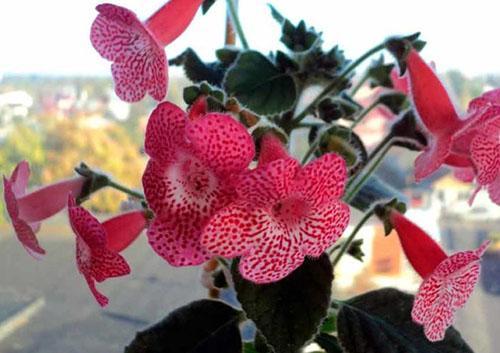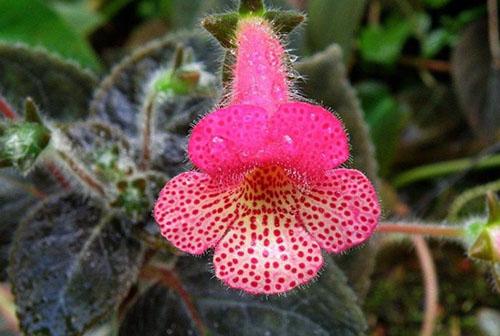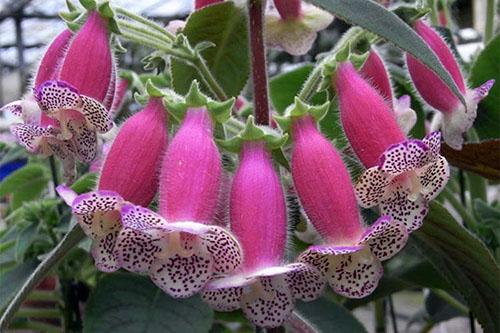What should be the care for the color scheme at home
 The popularity of growing room color is due to its high decorative effect and a long flowering period. Despite the exactingness to the temperature and humidity characteristics of the air and the quality of the soil, caring for color at home is very simple. From this publication, you will learn about the most common varieties, maintenance features and breeding methods of this unpretentious plant.
The popularity of growing room color is due to its high decorative effect and a long flowering period. Despite the exactingness to the temperature and humidity characteristics of the air and the quality of the soil, caring for color at home is very simple. From this publication, you will learn about the most common varieties, maintenance features and breeding methods of this unpretentious plant.
Description of the plant

In nature, coleria is a perennial climbing plant with elongated, rather large and velvety leaves, which, depending on the species, can have a wide variety of colors with shades of green, bronze and silver.
Coleria flowers are bell-shaped with five petals, decorated with a contrasting pattern. As a rule, varieties of kaleria with red flowers are grown under artificial conditions, less often with bard and orange flowers. Depending on the species, the number of flowers on a peduncle varies from 1 to 3.
The flowering plant usually begins in late May (early June) and lasts until mid-October. The dormant period is from late October to mid-March. A characteristic feature of the plant during the transition to the dormant phase is the cessation of flowering, active foliage discharge, wilting of the apical shoots. However, in favorable climatic conditions and with proper care, the indoor flower kaleria can bloom almost all year round.
Types of koleria suitable for growing at home
Of the 40 known varieties of koleria, only 11 have adapted well to growing in artificial conditions. Among the varieties most popular among domestic flower growers, the following varieties can be noted:
- "Nice". This species is distinguished by the presence of long shoots, dark green foliage, covered with thick pile. The color of the flowers ranges from pink to bright red with white blotches.

- "Bogotskaya". A very large plant with a rich color of leaves, the length of which reaches 10 cm. Flowers are yellow-red with a bright burgundy pattern on the petals.

- Lindena. A low-growing plant, reaching 30 cm in height when grown at home. A characteristic feature of this variety is the presence of leaves of a rich green color with white villi on the front of the leaf plate. On the back of the leaf, the villi have a pink tint.

- "Fluffy". A tall specimen with bright and rich green leaves, which have a reddish tint along the edge. The flowers are small, bright red or orange in color.

- "Spikelet". It is considered the smallest among indoor flower varieties. The length of the bush, as a rule, does not exceed 30 cm. The leaf plates are oval, dark green in color. Buds are small, bright orange.

- "Tube-flowered". A medium-sized plant, reaching a height of 40 cm.It differs from the entire species diversity in the tubular shape of flowers, in which there is no bent part of the petals. The leaves are dark green with a pronounced pile.

- "Hairy". Plant with straight shoots covered with fine hair. Leaves are oval, deep green shade with purple edging.

In addition to the aforementioned varieties, hybrids are very popular among flower growers. The following hybrids can be found in specialized stores: Peridot's Rolo; Flashdance; Queen victoria; Bibbi. A very decorative hybrid "Varshevich" is distinguished by lilac flowers, covered with thick silvery pile.
The folded part of the petals has a white-yellow color with dark patches.
Features of caring for color at home
 As noted above, the "Colombian beauty" is a very unpretentious plant that usually does not require special conditions for keeping. Nevertheless, like any “native” inhabitant of the tropics, the plant requires a sufficient amount of light and moisture. The only condition is the organization of the diffused light. The sun's rays are detrimental to the vegetative part of the plant. Next, let's look at how to care for a kaleria flower at home.
As noted above, the "Colombian beauty" is a very unpretentious plant that usually does not require special conditions for keeping. Nevertheless, like any “native” inhabitant of the tropics, the plant requires a sufficient amount of light and moisture. The only condition is the organization of the diffused light. The sun's rays are detrimental to the vegetative part of the plant. Next, let's look at how to care for a kaleria flower at home.
Temperature and humidity
 For active growth, the plant needs an increased ambient temperature. In the summer, the optimal indicator is from +24 to + 30 ° С; in the cold season, the optimal temperature range is from + 15 to + 17 ° С. The humidity in the room with the "Colombian bell" should be within 55%.
For active growth, the plant needs an increased ambient temperature. In the summer, the optimal indicator is from +24 to + 30 ° С; in the cold season, the optimal temperature range is from + 15 to + 17 ° С. The humidity in the room with the "Colombian bell" should be within 55%.
Watering
 Watering the plant needs moderate. Optimally, this is root watering with settled water every 7 days.
Watering the plant needs moderate. Optimally, this is root watering with settled water every 7 days.
Do not overmoisten the soil and spray the green mass of the plant. Excessive moisture in the soil can provoke lesions by fungal infections, and droplets of water on the leaves can cause decay.
Plant care in winter
 When the plant enters the resting phase, the bush should be cut to ground level, and then the container with the kaleria should be moved to a dark and cool place. Moistening the soil during such a period should be done no more than 1 time in 30 days.
When the plant enters the resting phase, the bush should be cut to ground level, and then the container with the kaleria should be moved to a dark and cool place. Moistening the soil during such a period should be done no more than 1 time in 30 days.
Ground requirements
 Kaleria loves light, nutritious, slightly acidic soil with good water permeability characteristics. The best option is a specialized soil mixture for Gesneriaceae. In the absence of such on sale, the soil for the "Colombian beauty" can be made independently. To do this, you need to mix in equal proportions: peat, garden land, river sand.
Kaleria loves light, nutritious, slightly acidic soil with good water permeability characteristics. The best option is a specialized soil mixture for Gesneriaceae. In the absence of such on sale, the soil for the "Colombian beauty" can be made independently. To do this, you need to mix in equal proportions: peat, garden land, river sand.
Top dressing
All genseries respond well to mineral fertilizers and organics. Fertilizers should be applied every 14 days, starting in spring and ending with the first manifestations of the transition to the resting phase. During the period of active flowering, the plant needs regular feeding. Lush bloom will ensure that potash and phosphate fertilizers are applied to the soil every two weeks.
Crown formation
 Trimming the top shoots of a bush allows for a lush flower. If you do not carry out the crown formation procedure, then the plant will be ampelous. This form is also highly valued among domestic florists.
Trimming the top shoots of a bush allows for a lush flower. If you do not carry out the crown formation procedure, then the plant will be ampelous. This form is also highly valued among domestic florists.
It should be understood that the formation of the crown is allowed only before the onset of the period of active growth and flowering of the plant.
Transplant and reproduction of coleria at home
 Transplant "Colombian bell" only in the spring before the onset of the active growth phase of the plant. To do this, choose a shallow wide container, which will ensure maximum saturation of the soil with oxygen.
Transplant "Colombian bell" only in the spring before the onset of the active growth phase of the plant. To do this, choose a shallow wide container, which will ensure maximum saturation of the soil with oxygen.
Coleria propagates by cuttings, seeds and parts of the rhizome, which in this plant are called rhizomes. The most popular propagation methods are apical cuttings. Such shoots take root equally well both in water and directly in the ground. Already on the 10th day, roots and new shoots necessary for the normal rooting of the plant will appear in the place of the shoot cut.
When rooting the cuttings in the ground, cover the shoot with a plastic container to create a greenhouse effect.
Coleria rhizomes are growths on the root system, which serve to create the necessary supply of nutrients and moisture for the plant. It is very simple to propagate a flower with rhizomes: it is enough to put them in a pot on a layer of substrate and sprinkle with a soil mixture, with a layer of 3-4 cm.
Rhizomes can appear not only on the roots, but also on the shoots, as well as on the leaves of kaleria.
Of these, young shoots appear even in the air, which can be easily planted in the ground as described above.
Unpretentious collier at home - video